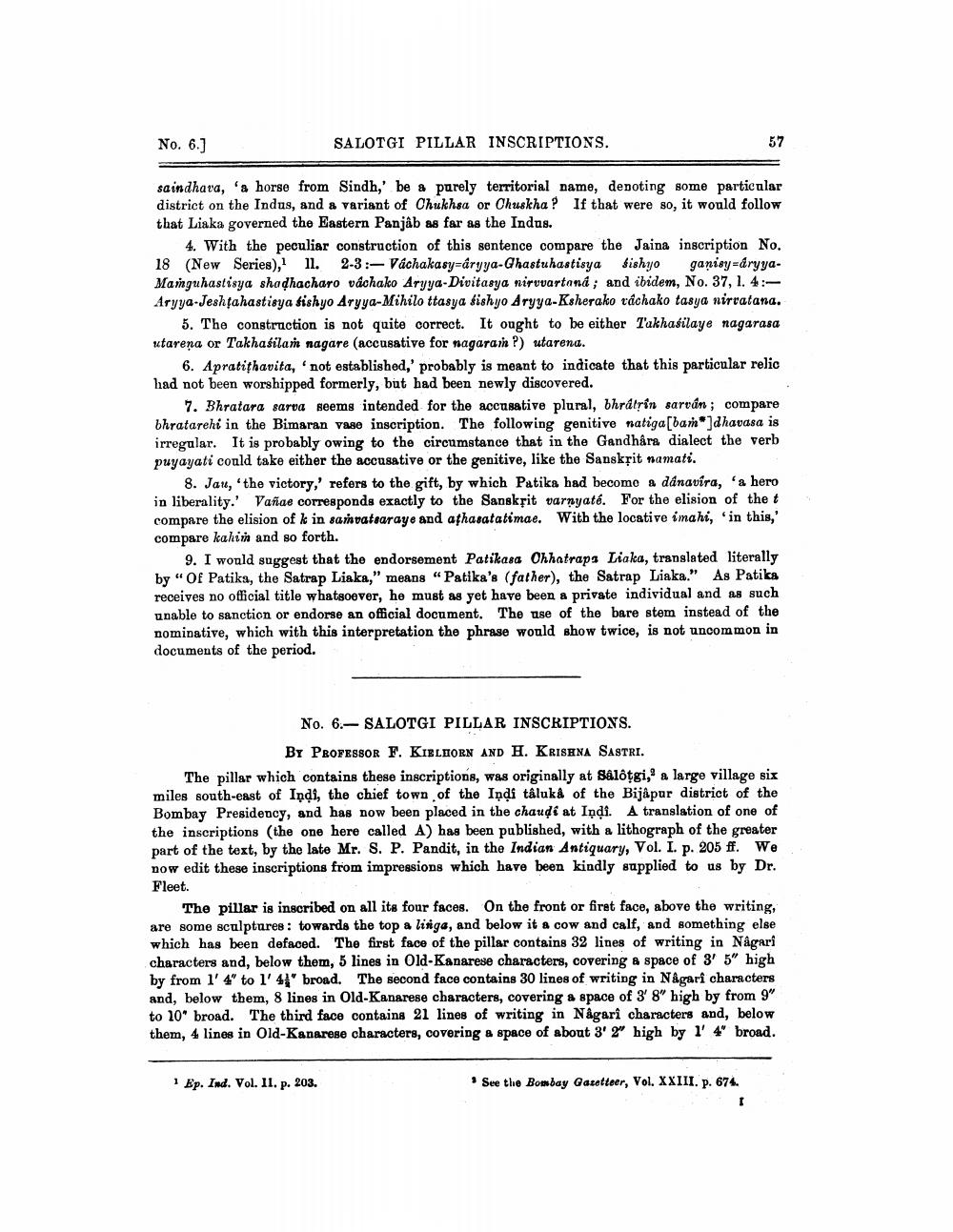________________
No. 6.]
SALOTGI PILLAR INSCRIPTIONS.
saindhava, a horse from Sindh,' be a parely territorial name, denoting some particular district on the Indus, and a variant of Chukhsa or Chuskha ? If that were so, it would follow that Liako governed the Eastern Panjab as far as the Indus.
4. With the peculiar construction of this sentence compare the Jaina inscription No. 18 (New Series). 11. 2-3:- Váchakasyraryya-Chastuhastisya Sishyo g aniay=dryya. Mamguhastisya shadhacharo váchako Aryya-Divitasya nirvvartana ; and ibidem, No. 37, 1. 4:Aryya Jeshtahastisya fishyo Aryya-Mihilo ttasya fishyo Aryya-Ksherako rdchako tasya nirratana.
5. The construction is not quite correct. It ought to be either Takhasilaye nagarasa utarena or Takhasilan nagare (accusative for nagarai ?) utarena.
6. Apratithavita, 'not established,' probably is meant to indicate that this particular relic had not been worshipped formerly, but had been newly discovered.
7. Bhratara sarva seems intended for the accusative plural, bhràtrin sarván; compare bhratarehi in the Bimaran vase inscription. The following genitive natiga[bam]dhavasa is irregular. It is probably owing to the circumstance that in the Gandhâra dialect the verb puyayati could take either the accusative or the genitive, like the Sanskřit namati.
8. Jan, 'the victory,' refors to the gift, by which Patiks had becomo a danavira, 'a hero in liberality.' Vaflae corresponds exactly to the Sanskpit varnyaté. For the elision of the t compare the elision of k in samvatsaraye and athasatatimae. With the locative imahi, 'in this,' compare kahim and so forth.
9. I would suggest that the endorsement Patikasa Ohhatrapa Liaka, translated literally by "Of Patika, the Satrap Liaka," means "Patika's (father), the Satrap Liaka." As Patika receives no oflicial title whatsoever, he must as yet have been a private individual and as such unable to sanction or endorse an official document. The use of the bare stem instead of the nominative, which with this interpretation the phrase would show twice, is not uncommon in documents of the period.
No. 6.- SALOTGI PILLAR INSCRIPTIONS.
BY PROFESSOR F. KIBLHORN AND H. KRISHNA SASTRI. The pillar which contains these inscriptions, was originally at såloggi, a large village six miles south-east of IŅdi, the chief town of the Iņdi tâluka of the Bijapur district of the Bombay Presidency, and has now been placed in the chaudi at Indi. A translation of one of the inscriptions (the one here called A) has been published, with a lithograph of the greater part of the text, by the late Mr. S. P. Pandit, in the Indian Antiquary, Vol. I. p. 205 ff. We now edit these inscriptions from impressions which have been kindly supplied to us by Dr. Fleet.
The pillar is inscribed on all its four faces. On the front or firet face, above the writing, are some sculptures : towards the top a litiga, and below it a cow and calf, and something else which has been defaced. The first face of the pillar contains 32 lines of writing in Nagari characters and, below them, 5 lines in Old-Kanarese characters, covering a space of 3' 5" high by from 1' 4" to 1' 41' broad. The second face contains 30 lines of writing in Någari characters and, below them, 8 lines in Old-Kanarese characters, covering a space of 3' 8" high by from 9" to 20" broad. The third face contains 21 lines of writing in Nagari characters and, below them, 4 lines in Old-Kanarese characters, covering & space of about 3' 2" high by 1' 4" broad.
1 Ep. Ind. Vol. II. p. 203.
See the Bombay Gazetteer, Vol. XXIII. p. 674.




